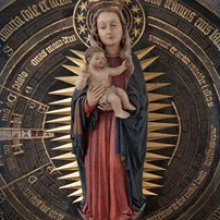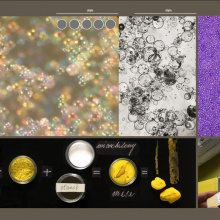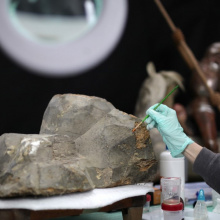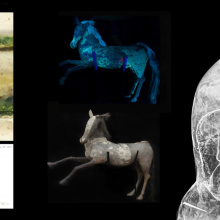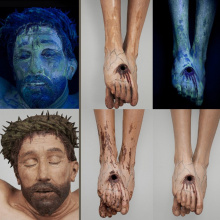Gdansk citizens and their passions - St Mary's Church in Gdansk - is a lecture series organised by the Gdansk University Institute of Art History in cooperation with the Institute for Urban Culture. The next online meeting, devoted to conservation works and research on the most valuable works of art of the Gdansk church, is scheduled for May 11, 2021. dr hab. Andrzej Wozinski prof. UG from the Faculty of History UG will talk about the medieval altars reredoses.
Ewa Karolina Cichocka talks with prof. UG Andrzej Woziński about research and conservation works on the most important temple in Gdansk.
- You are a member of the Scientific and Conservator's Council at St. Mary's Church, which has determined the scope of works in this monument. The series of meetings entitled 'Gdansk citizens and their passions - St. Mary's Church in Gdansk', which began in April, presents some of the stages of research and conservation works. What was their scope?
- The revitalisation and conservation of St Mary's Church, carried out between 2017 and 2020, was probably the most serious and extensive project of this kind in the intermediary history of the church. The work included cleaning the external walls, providing a new roof covering, tidying up the tombstones in the floor and conserving numerous pieces of equipment, particularly those in the chancel and its immediate vicinity, including the retable of the main altar, the astronomical clock and the Passion Play over the entrance to the chancel. The research work was closely connected with the work of the conservators.
- The research in which the scientists from the University of Gdansk participated concerned some of the most important objects - the 15th-century group of crucifixions in the beautiful style, the astronomical clock or the medieval altars, of which perhaps the largest collection in Europe was in our temple? Your lecture on May 11 will be devoted precisely to the reredoses of medieval altars.
- I will talk about the equipment of the temple, especially about the medieval reredoses, of which there were about 50 in the church around the year 1500. In this respect, St Mary's Church belonged to the richest churches of those times.
The owners of altars, on which reredoses stood, apart from the main altar, were patrician families, brotherhoods and craftsmen guilds. The reredoses represented different types and were not only the work of local artists, many of them were imported from abroad - for example from the Netherlands and England. Their origin reflected the cosmopolitan character of late medieval Gdansk, and their owners represented the upper and middle classes of our city's community.
- What all Gdansk citizens can see is the replacement of the roofing and the conservation of the floor in St. Mary's Church. Further work on the monuments must have been carried out in the comfort of conservation studios?
- When conserving the largest objects, the studios were organised in the church itself. This was the case, for example, with the conservation of the main altar retable and the Passion from 1517, where the workshop was located on scaffolding, over 20 metres above the floor.
- Have the works carried out in one of the oldest churches in Gdansk revealed any previous conservation errors or hidden secrets, repaintings or mysterious inscriptions?
- Yes, for example, the conservation of the retable of the main altar corrected some unsuccessful procedures of the former conservators. Above all, it has put the wings in an order corresponding to the original and, what is more, thanks to the work of the conservators, the wings have regained their mobility. On one of the wings of the main altarpiece retable, the inscription Anno Domini 1510 was discovered, which is the date when work on this piece began.
- How many other works require specialist conservation work? What will they consist of? Will we be able to hear more about them?
- I cannot answer precisely. This is a matter that is agreed with the conservators and the church administrator. The main work was completed in 2020, but certainly, other monuments which require it will undergo conservation.
- The series of meetings in which the Professor participates coincides with the completion of successive stages of conservation work. Thanks to the lectures, it has been possible to look into places difficult to reach for visitors and to pass on the latest knowledge to Gdansk enthusiasts and researchers as quickly as possible before they appear in publications. Will there be collective work summarising the results of the work carried out?
- There is such an idea, but it is still vague. I know that in the nearest future there are plans to publish further volumes devoted to St. Mary's Church. So far two volumes of this series have been published. Moreover, it is planned to publish a study related to the conservation of the main altar retable.
The Institute of Art History of the University of Gdańsk in collaboration with the Institute of Contemporary Art invites you to the next meeting in the series Gdansk Citizens and their Passions.
May 11 - prof. UG Andrzej Woziński, Medieval altar retables
May 25 - dr Anna Sobecka, Protestant elements of the equipment of the Blessed Virgin Mary church
June 8 - Krzysztof Owsiany, Conservation of the organ prospectus from the Church of St. John
Previous lectures can be viewed on youtube:
Krzysztof Owsiany, Conservation of the main altarpiece by Master Michael of Augsburg
https://www.youtube.com/watch?v=sYmQ18xpPsI
Ewa Lisiak, Polychromies of Medieval Sculptures in the NMP Church in Gdansk

